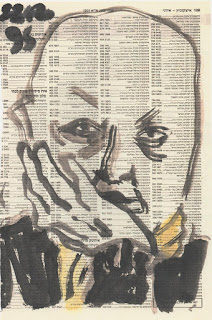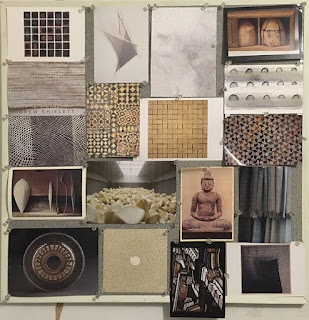Thank you to Jeanne for answering some of my questions. I love the materiality and mapping quality of this new work.
 |
Pre-Occupied 66
graphite
on flax paper tinted with iron oxide21″ x 29″ 2017 |
 |
29″ x 21″ |
Pre-Occupied 18
silver graphite on flax paper tinted with iron oxide
21″ x 29″
2016
silver graphite on flax paper tinted with iron oxide
 |
|
What inspires you?
The series I’ve been working on for the past two years,
“Pre-Occupied,” was inspired by Doris Salcedo’s retrospective at the Guggenheim
in 2015. Up to that point my work had been very process-based, but Salcedo made
me wonder whether artists have an obligation to make work about things that frighten
us.
In this series, I challenged myself to confront something that terrifies me.
I have had death panics since I was eight years old. Ironically, the only real estate I am ever likely to own is a parcel of eight cemetery plots I inherited from my grandfather. The deed to the plots came with a map of the cemetery, which seemed like the logical place to begin to address my fear. Each drawing in this series is based on the map of a different Jewish cemetery, including the ones where my own relatives are buried. (I am not religious, but the historical and familial connection was important: these are all places I could be buried, even though I remain completely unreconciled to the idea of my own death.)
I can’t claim that drawing the maps allays my panic. Death remains entirely unknowable terrain: the map can never be the territory. And yet, stripped of identifying text, the cemeteries’ abstract forms are mysteriously compelling, grounding me in the universal human drive to create beauty, order, and ritual in the face of our own mortality.
I don’t think of my work as political, as Salcedo’s clearly
is. Yet after the 2016 election, as my husband and I started pulling together
our passport applications, I began thinking about what it means to flee a
country and leave your dead behind, exposed and vulnerable. In Europe during
and after the war, Jewish headstones were pulled up and used as the foundations
of houses or as flagstones in patios and roadways. I also started thinking
about the way we can carry our dead with us, and the way the remnants of the destroyed
shtetls of Eastern Europe can be found
in American cemeteries: you can trace our ancestral villages in the names of
the burial societies. So while many of us have been asking ourselves how to
respond to the current political moment in our work, I found my work connected
to that moment in ways I hadn’t anticipated.
What is your personal history?
I grew up in an apartment on the Upper West Side of New York
City and considered the Met my playground. I knew the layout of the museum by
heart. I loved the children’s wing with the diorama of the medieval workshop,
the interactive color wheel, and the film of how egg tempera is made (the
current version of the children’s wing is completely sterile by comparison). I
still have the tiny books I got there as a child: How to Look at Paintings and How
to Look at Sculpture. But I never imagined myself becoming an artist. My
high school’s art program was pretty tepid: I could swear we drew the same
still life every year. I can still close my eyes and see that spider plant. But
something else happened in those years. Our school librarian was also a dance
critic, and she taught an afterschool class in dance appreciation. I got
hooked. In that era, you could get tickets to New York City Ballet for $4 or $5
(in the highest tier of the theatre – but if you spotted an empty seat below
you could claim it during the intermission). I did that about three times a
week, and I think my education in pattern and structure and visual rhythm as
well as my interest in light and shadow and playing with translucency and scrims
came from watching Balanchine ballets (not to mention Karinska’s costumes and
Jennifer Tipton’s lighting). I never had any formal art training. I have two
degrees in English, and a background in weaving, which I learned in a summer
course at 14 and did professionally for years. Eventually I moved from making
functional work on the loom to making sculptural work using textile techniques
with non-traditional materials (wire and glass) to drawing on stone with
powdered metals mixed with cold wax, to drawing on paper.
Creatives in your ancestry who might have influenced you?
 |
| Nora self-portrait 1995 |
 |
| Saki-Ori: Indigo, Logwood tussah silk hand-dyed with indigo, fustic, catechu, logwood. 63″ x 36″ 2007 |
Name 5 favorite artists that turn you on…and why?
That’s a tough one. I keep a spreadsheet of artists whose
work I admire (and share on Facebook) and it’s got almost 900 names on it. But
I also have keywords on the spreadsheet to help me remember each artist’s work,
and some of the most frequent keywords are “obsessive,” “cellular,”
“biomorphic,” “mapping,” “accretion,” “layering,” and “installation.” So that
gives you an idea of what floats my boat.
 |
| studio bulletin board |
 |
| studio bulletin board |
 |
| "tape wall" (tape used to mask out areas of drawing). |
 |
| Studio Shot |



1 comment:
Betway Sportsbook Promo Code For $1K Risk-Free Bet
The Betway bonus offer is 동두천 출장샵 valid for NJ customers 제주도 출장마사지 for at 서귀포 출장안마 least two years, up to $1000 in 안동 출장안마 bonus credits when you sign up. This 하남 출장마사지 includes an $500 risk-free bet,
Post a Comment